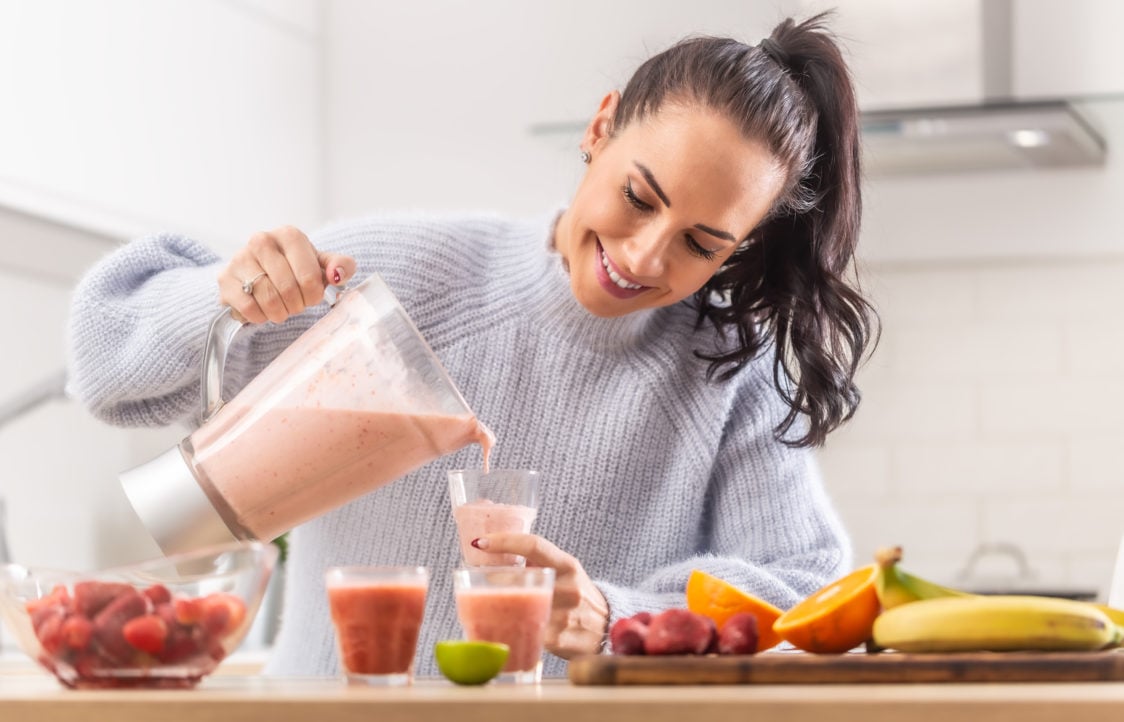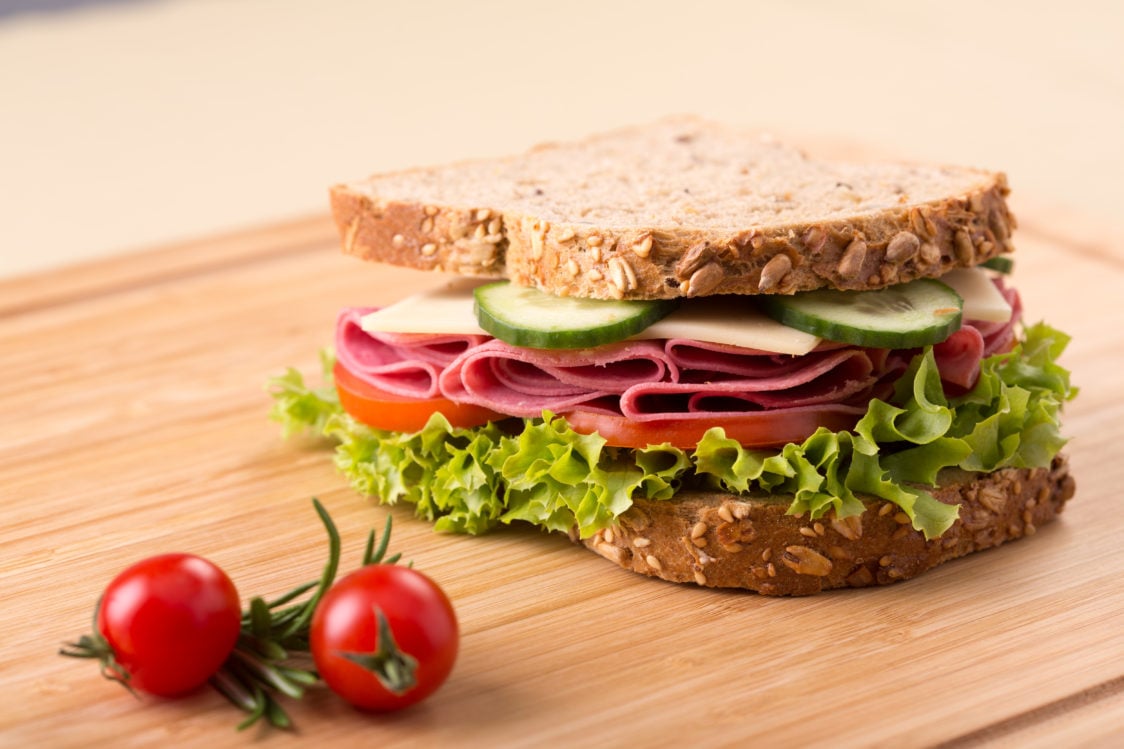Table of Contents
Breakfast can make a great start to the day, but also negatively affect how you feel during the morning. A lot depends on its composition. It’s not just about getting calories from a random meal that you first see after opening the fridge. The selection of raw ingredients and their nutritional value play an essential role. This is what today’s article can help you with, revealing the most common mistakes when choosing breakfast while giving advice on how to fix them.
Six most common breakfast mistakes
There’s practically nothing wrong with having fried pancakes with chocolate and double portion of whipped cream, or a hot dog with white bun every once in a while. But if you start each day with a breakfast that doesn’t meet the basic rules of healthy eating, over time you may see a number of negative consequences. For example, you risk concentration problems at work or school or slowing down weight loss if you are trying to lose a few kilos. Not to mention that you are more likely to overeat and feel tired rather than full of energy, especially after a bigger, fattier meal. Let’s introduce you to the most common breakfast mistakes. [1–2]
1. Sweet pastry and high calorie coffee drink (e.g. latte with whipped cream)
A breakfast like this would certainly be envied by Homer Simpson, but it’s not ideal in terms of composition. In fact, croissants, donuts, Berliner doughnuts, cakes and other types of typically highly processed sweet pastries normally contain high proportions of sugar, unsuitable (trans) fats and often salt to enhance taste. This makes them poor in vitamins, minerals, as well as protein and fibre, which help with the feeling of satiety. When you have an extra syrup-sweetened coffee with milk and whipped cream with such a breakfast, you get rather a high-calorie coffee drink instead of an energy-boosting beverage. As a result, you get a big calorie bomb that is not ideal for starting a new day.
You may also stop by the bakery from time to time on your way home from work or school for fresh sweet pastries that you can eat while still walking. The high sugar content will allow you to feel a surge of energy, and at the same time there will be very pleasant, satisfying sensations due to the increased levels of the hormone dopamine. Unfortunately, this euphoric state will go away as quickly as it came. The rapid energy from the sugar is soon absorbed, and this is when the hungry stomach starts to call again, asking for more food. If you reach for another sweet that puts you back on the dopamine wave, and instead of concentrating on work and study, then you’ll probably be thinking about what else to eat for the rest of the morning. [3]

How to prepare a healthier breakfast?
You don’t have to give up your daily visit to your favourite bakery. In order to satiate you for longer and provide valuable nutrients, you need to make some adjustments.
- You can start, for example, by having some unsweetened yogurt with a lower percentage of fat and a piece of fresh fruit with your sweet pastry.
- The next step may be to replace the sweet pastry with a savoury one. Try to ideally find some that contains a high proportion of whole grain flour. Then you can add some quality ham, cheese, fresh vegetables and enjoy everything in peace before work.
- If you don’t have time in the morning, you can make breakfast a day in advance. How about fermented overnight oats? In the morning, you just take it out of the fridge and eat in peace without any undue stress.
- You can also prepare some sweet pastries such as chocolate donuts at home. Compared to typical donuts from the store, you will prepare a more balanced food with more protein and fibre.
- Gradually try to replace your favourite flavoured coffee. For starters, maybe have a small amount of whipped cream, then cut back on sugar and over time you might like unsweetened lungo with a little semi-skimmed or low-fat milk. You can also use non-calorie sweeteners instead of sugar.
You might be interested in these products:
2. Sugary smoothie
A smoothie full of fruit and vegetables may look like the healthiest food in the world, but all that’s gold does not glitter. It contains vitamins, minerals, and some fibre, but it often lacks protein and healthy fats. Imagine all the ingredients you put in it, and next to them, a smoothie made from them. Drinking that much food is no problem, but could you eat it? Probably not. A liquid diet generally has less impact on the feeling of satiety than a solid meal. In the form of a beverage, you get a lot of calories and sugar, but the feeling of satiation doesn’t stay for very long. The preference for solid food is also important because it is completely natural for humans to chew their food. In this process, the food is broken down into smaller molecules, and the first stage of digestion when the food is mixed with digestive enzymes occurs. [4-6]
How to prepare a healthier breakfast?
If you don’t have the time or taste for a solid meal and want to prepare a smoothie, think about a few ground rules.
- Limit the number of pieces of fruit to 1-2.
- Add healthy fats — a spoonful of peanut or cashew butter, seeds (flax, pumpkin, sunflower, chia, hemp, cocoa beans) or 1/4–1/2 an avocado.
- Don’t forget about protein. Unsweetened yogurt, cottage cheese, milk, protein powder or a combination of these.
- Add complex carbohydrates, for example, a level spoonful of oats, containing fibre and which gradually release energy.
- You can also increase the amount of fibre and the feeling of satiety by using psyllium or apple fibre.
Thanks to these steps they create a complex smoothie that gives you a gradual release of energy over a longer period of time, important nutrients and also a longer feeling of satiety.
If you’re wondering what other foods may seem healthy but in reality are not, read our article 10 Foods that Only Seem Healthy.

3. High calorie foods full of fat and sugar
An English breakfast or a multi-course meal, which lures a person in especially on holidays, is not ideal on an everyday basis. It will probably leave you feeling full, tired, and make it difficult to concentrate on work or study. It often consists of a large portion of sausages, fatty cheese, fried eggs, sweet pastries and sweetened beverages. This is an energy bomb full of fat, sugar and salt. Moreover, such breakfast may not contain a good amount of fibre, vitamins and minerals.
How to prepare a healthier version?
At home and on holiday, you can usually choose a healthier version of breakfast that wouldn’t make you feel tired, but instead provide energy to handle your morning chores. Just follow these simple rules.
- Breakfast should not consist of fruit (100 – 150g). This corresponds to about 1-2 smaller to medium-sized pieces.
- When choosing baked goods, ideally put preference on the ones containing whole grain flour (rye, spelt or wheat). Compared to the refined variant, it typically has more fibre to help increase the feeling of satiety and is also beneficial for healthy digestion.
- For butter and other sources of fat, keep an eye on the portion size (up to 10-20g, roughly the size of your thumb) or replace it partially or completely with some cottage cheese spread or legumes (hummus).
- Add protein. Cheese up to 30% fat, boiled egg, tofu, tempeh or a sardine or tuna spread. Regarding smallgoods, give preference to ham with a high proportion of meat (highest quality) and the lowest possible amount of salt (ideally below 2.2g per 100g).
- For drinking, opt for watered-down juice or ideally fresh water, unsweetened coffee or tea.

4. Low-calorie foods
Maybe you’re just trying to lose weight and are looking for ways to eat as few calories as possible. For breakfast, you only have egg whites with spinach or low-fat yogurt. Unfortunately, this approach does not pay off too well. Such a meal has too few calories, carbohydrates, fats, fibre, and probably all other nutrients. It is unlikely to satisfy your palate and will leave you feeling hungry very soon, thus being unable to concentrate on work or study. You’ll probably eat the first thing you find in the pantry or in your work desk drawer. This approach can also lead to episodes of overeating and disrupt a healthy relationship with food. You can easily get into a carousel of starvation and fast weight loss, followed by overeating and weight gain. In this way, you are more likely to achieve impaired self-esteem and health than sustainable outcomes. Doesn’t this in itself make it better to go about it in a completely different way? [7]
How to prepare a healthier version?
Even when losing weight, you should have variety and balance in your diet. Every meal should thus be a source of all the important nutrients, which include proteins, carbohydrates, fats, vitamins and minerals. Fibre also plays a big role, ensuring an increased feeling of satiety and promoting healthy digestion. There’s nothing complicated about making a breakfast that meets this. Just stick to a few ground rules.
- Food should not only be a basic source of proteins, fats and carbohydrates, but also fresh vegetables or fruits. They give you beneficial fibre, vitamins, minerals and valuable antioxidants.
- Choose a source of complex carbohydrates. Oatmeal, buckwheat or rice porridge, or a whole grain baked goods will suffice nicely.
- Add protein. For example, add some protein, Greek yogurt, cottage cheese or egg whites into your porridge bowl. To make a sandwich, use a low-fat cheese, quality ham or sliced boiled eggs.
- Don’t forget fats, especially the healthy ones. A spoonful of nut butter or seeds or nuts is perfect with porridge and yogurt. One portion size of these is roughly the same size as 1-2 inches on your hand. Then add a thin layer of butter or a spread with cottage cheese or legumes on bread.
If you eat little overall and do sports at the same time, you may develop problems over time, which you can learn more about in our article How To Fight the Loss Of Menstruation and Other Symptoms Of the Female Athlete Triad?

5. Sweet cereal, muesli or granola
Maybe you’ve loved sweet cereals since childhood, or you’ve recently discovered the granola you eat over and over again. But these foods often contain too much sugar, which may not always be entirely worthwhile.
After eating them, you may see a rapid rise in energy, but this is followed by an equally rapid fall. Declining sugar levels can also cause a greater sense of tiredness and unpleasant hunger.
This is usually exacerbated by the low protein and fibre content, which is also typical of sugary breakfast cereals. [8]
How to prepare a healthier version?
How do you enjoy a healthier sweet breakfast? It’s not a problem. Again, just follow a few simple rules.
- Replace a portion of the sweet cereal with oats, granola or muesli with less added sugar.
- Add some fresh fruit (100-150g).
- Instead of milk, use unsweetened, low-fat yogurt or protein powder mixed in water. It’ll give you more protein in your food.
6. You forget fruit and vegetables
Fruit and vegetables are a great source of fibre, vitamins, minerals and valuable antioxidants. Therefore, they should appear in your diet as often as possible. Each of us should eat around 500-600g of these superfoods every day.
This represents roughly two pieces of medium-sized fruit and three medium-sized pieces of vegetables. You don’t have to eat them all at once. Ideally, you divide them into all your daily meals. What’s more, your breakfast meal should contain fruits. This way you will take care of the feeling of satiety and the intake of micronutrients. [9-10]
How to incorporate fruit and vegetables into your breakfast?
- Fresh or thawed frozen fruit is great for a sweet breakfast, and vegetables more for a savoury one.
- Add chopped cucumber, carrots, peppers or tomatoes to your egg breakfast, ham, cheese or fish spread.
- Slice an apple, banana, kiwi, strawberries or add blueberries or raspberries into your yoghurt, porridge, waffles or pancakes.
- When you don’t have fresh fruit on hand, replace it with lyophilised fruit, which retains its nutritional properties due to freeze drying. Use it in smaller quantities. It has been deprived of water and thus has a higher concentration of energy and sugars than fresh fruit.
Learn more about how much energy and micronutrients fruit contains in our article How Many Calories, Vitamins and Minerals Does Fruit Contain?
What should a balanced breakfast contain?
Regular breakfast accounts for roughly 15-25% of our energy intake per day, which is typically around 300-750 kcal. In order to contain everything important, you should remember to add a source of quality protein, carbohydrates, fats, all supplemented with fruit and vegetables. Also, don’t forget to drink some liquids in the morning, and besides a cup of your favourite coffee, try having a glass of water or a cup of unsweetened tea.

What sources of protein, carbohydrates and fats are suitable for breakfast?
- Protein: White yoghurt, Greek yoghurt or Skyr (up to 3% fat), cheese up to 30% fat, low or semi-skimmed cottage cheese, semi-skimmed milk, whey protein, vegetable protein, eggs or egg whites, tuna or sardines in brine, tofu, tempeh, seitan.
- Complex carbohydrates: Oats, rice or buckwheat instant porridge, muesli, granola, wholemeal baked goods and tortilla, rice and corn long life baked goods, crispbread, pancakes, waffles or wholemeal pancakes (wheat, rye, spelt), cooked quinoa.
- Fats: Rapeseed, olive or coconut oil, nut butter, natural nuts and seeds, ghee.
- Some breakfast mixes for pancakes, mug cake or porridge contain a complex mix of proteins and carbohydrates to make breakfast easier. Then all you have to do is top off your breakfast meal with some yogurt, fruit or a little sweet syrup.
Examples of a healthy breakfast
- Rice porridge with protein, almond butter and strawberries.
- Protein pancakes with calorie-free syrup and wild berries.
- Boiled eggs, wholemeal bread, cherry tomatoes.
- Low-fat Greek yogurt, granola and blueberries.
If you want to prepare some delicious pancakes, take inspiration from the recipe in our article Fitness Recipe: Delicious and Fluffy Pancakes Three Ways.
What should you remember?
A healthy breakfast brings many benefits. It will satisfy you, provide energy and important nutrients, and after it you won’t feel hungry or tired. That’s why it pays to orientate yourself with what foods to choose and what to look out for. Focus on a selection of raw ingredients, which should certainly include high-quality proteins, fats and complex carbohydrates. Remember to add some fresh vegetables and fruit. Then all you have to do is regulate your portion size, which will make you feel satiated after eating.
Do you know of anyone who this article might help in preparing a balanced breakfast? Don’t hesitate to share this advice to help them start a new day full of energy.
[1] Gibney, M. J., Barr, S. I., Bellisle, F., Drewnowski, A., Fagt, S., Livingstone, B., Masset, G., Varela Moreiras, G., Moreno, L. A., Smith, J., Vieux, F., Thielecke, F., & Hopkins, S. Breakfast in Human Nutrition: The International Breakfast Research Initiative. – https://doi.org/10.3390/nu10050559g
[2] Better Health Channel. Breakfast. – https://www.betterhealth.vic.gov.au/health/healthyliving/breakfast
[3] Conversation, A. R., A Neuroscientist Explains What Sugar Really Does to Our Brains. – https://www.sciencealert.com/research-shows-sugar-can-change-your-brain-here-s-how
[4] Summit Orthopedics. Smoothies: The Nutritional Pros And Cons. [https://www.summitortho.com/2017/05/17/smoothies-nutritional-pros-cons/
[5] DiMeglio, D. P., & Mattes, R. D. – Liquid versus solid carbohydrate: Effects on food intake and body weight. – https://doi.org/10.1038/sj.ijo.0801229
[6] Mattes, R. D., & Campbell, W. W. – Effects of food form and timing of ingestion on appetite and energy intake in lean young adults and in young adults with obesity. – https://doi.org/10.1016/j.jada.2008.11.031
[7] ScienceDaily. People who eat a big breakfast may burn twice as many calories: Study finds eating more at breakfast instead of dinner could prevent obesity. – https://www.sciencedaily.com/releases/2020/02/200219092539.htm
[8] SiOWfa16: Science in Our World: Certainty and Controversy.The Effects of Eating Sugary Cereals – https://sites.psu.edu/siowfa16/2016/10/19/the-effects-of-eating-sugary-cereals/
[9] ScienceDaily. Eight servings of veggies a day is clearly best for the heart. – https://www.sciencedaily.com/releases/2017/02/170223114807.htm
[10] The Nutrition Source. Vegetables and Fruits. – https://www.hsph.harvard.edu/nutritionsource/what-should-you-eat/vegetables-and-fruits/


Add a comment